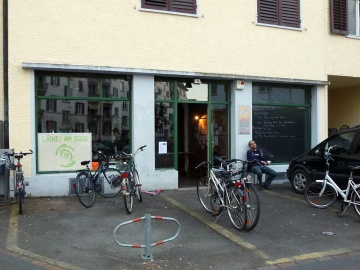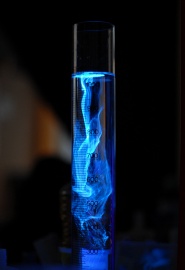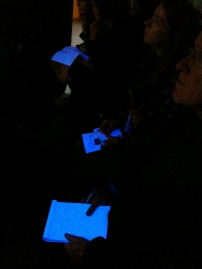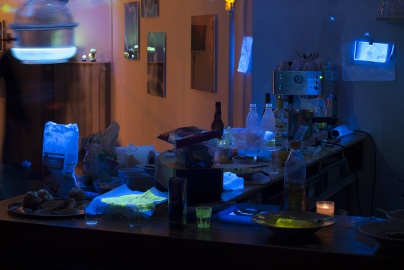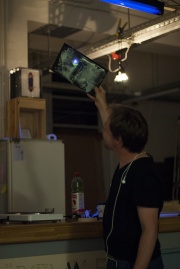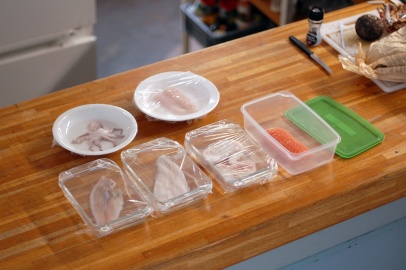Läb am Egge
Baggenstos/Rudolf, Brian Degger, Marc Dusseiller, Marianne Engel, Urs Gaudenz, Paula Pin, Sachiko Hirosue, Boris Magrini
Läb(e) am Egge | 20. – 26. Oktober 2014
Location
Reflection and documentations
During the whole process, starting from the first meetings, small collaborations in Summer 2014, in-depth research and expeditions by Andreas & Heidy, aswell as online collaborations of the whole team, various information has been gathered and documented on the wiki. See Explorations in BioLuminescence.
We are now collecting many photos and videos from all participants.
Pin's Photos of the Lichtpänomene workshop
and maybe there are more lost images somewhere on facebook....
let's put a best of here and write some description of what really happened!
Hintergrund
Das Projekt «Läb(e) am Egge» untersucht seit Sommer 2014 biologisches Licht von Tieren, Pflanzen und Bakterien. Mit einfachen Mitteln haben wir in unserem Studio ein Labor mit Mikroskop und den notwendigsten Utensilien und Chemikalien eingerichtet und begannen biolumineszierende Pilze und Bakterien zu züchten, um sie nach unseren Vorstellungen wachsen zu lassen.
Die Untersuchungen, Recherchen, Experimente und deren Ergebnisse veröffentlichen wir fortlaufend auf der folgender Webseite
In Zusammenarbeit mit Stefan Wagner vom Corner College und der Gruppe Hackteria ist im Vorfeld eine Talk/Präsentations - Reihe, «HSC - Hackteria Swiss Curriculum» entstanden, die seit Mai 2014 einmal monatlich stattfindet. HSC ist ein Diskussions-Format mit dem Ziel eine öffentliche Diskussion über verschiedene Aspekte von Bio art | Wissenschaft | Technologie und verwandte Praktiken zu führen.
Das «Läb(e) am Egge» ist aus dieser Reihe hervorgegangen, will aber zur diskursiven Ebene mit einem längeren Zeitrahmen auch einen Fokus auf praktische Labortätigkeit und konkretes Experimentieren legen.
Überblick
Vom 20. - 26. Oktober werden wir für eine Woche im Corner College Zürich ein „Bio-Labor“ einrichten und betreiben. Unsere öffentlich zugänglichen Laborexperimente werden ergänzt mit Präsentationen, Talks und Workshops von eingeladenen Gästen und Kollaborationen. (Siehe Programm.)
Dabei geht es uns darum verschiedene Professionen zusammen zu bringen. Das Kern Team besteht bereits aus KünstlerInnen, IngenieurInnen, BiotechnikerInnen und wir möchten dazu weitere Positionen und Blickwinkel ermöglichen. Wir lassen Kunst, Wissenschaft, neue Technologien und Geschichte aufeinander treffen und schauen was bei der Auseinandersetzung entsteht.
Mit Biolumineszenz wollen wir Licht in die, für viele verborgene, Laborwelt bringen. „Open source“, „Do it your self“, „Do it with others“ sind unsere Werkzeuge, um einen kritischen Blick auf die heutige Abhängigkeit von Pharma- und Chemieindustrie zu werfen.
Es wird ersichtlich werden, was für Infrastruktur benötigt wird, um ein minimales oder temporäres Labor zu betreiben. Schon mit geringem Aufwand ist vieles möglich und man kann mit entsprechendem Know-How einiges davon selbst bauen.
Ein ebenso zentraler Teil werden Phenomene sein, die in unserer Kultur beinahe in vergessenheit geraten sind. Bei vielen Leuten, wie auch bei uns, liess der Begriff Biolumineszenz zuerst an Leuchtkäfer und Tiere aus der Tiefsee denken. Dass aber auch Holz in unseren Wäldern leuchten kann ist vielen nicht bekannt.
Equipment Building
we have been building support structures for looking at measuring or glowing lab infrastructure buying
Schedule
Montag 20.10.2014
18h Opening
20h #HSC-Talk-Runde: Bio art labs conspiracy HSC#HSC.235:_The_Bioart_Lab_Conspiracy
- Luc, Yann & Robin von «Hackuarium» open & community-driven citizen biology lab in Renens/Lausanne
- Brian Degger, TransitLab, Bio-Hacking Space Newcastle
- Paula Pin, PechBlenda Lab, TransHackFeminist HardLab for Bio-Electro-Chemical-Experimentation
- dusjagr, NanoŠmano, Temporary labs for transdisciplinary production and artistic research
- Urs Gaudenz on Open Ego-Lab Networks, GaudiLabs, Luzern
- Temporary Labs, Hackteria and friends
Dienstag 21.10.2014
13h - 20h Offenes Labor
Mittwoch 22.10.2014
13h - 20h Offenes Labor
Donnerstag 23.10.2014
13h - 21h Offenes Labor
14h - 17h Workshop «Science Hacking with Brian Degger│TransitLab and Maker Space, Newcastle»
- Brian Degger is an art and science practitioner with a PhD in Molecular Biotechnology. In collaboration with artists and technologists, he uses scientific and open source methodologies to explore diverse research areas such as bacterial cultivation and fermentation, accessible science technology, aquatic ecologies and open source science. In his home town of Newcastle-Upon-Tyne with a small group of geeks, Brian set up Newcastle Maker Space, a place for creative use of technology.
17h - 21h Workshop «Das blaue Blut des Kastanienbaums│UV-Phänomene in der Natur»
- Helmut Brandl & Zoe Bont (Institute of Evolutionary Biology and Environmental Studies)
- Viele Sachen, die man in der Küche oder in der Natur findet (wie Pfefferminztee, Curry oder Eierschalen), fluoreszieren nämlich im UV-Licht. Wir werden mit Naturstoffen experimentieren und sie zum Leuchten bringen! Stellt man zum Beispiel einen Zweig der Rosskastanie in Wasser, so fliesst aus der Rinde Aesculin heraus, welches bei Bestrahlung mit UV-Licht stark blau leuchtet. Und mit ein wenig Chemie löst sich aus braunen Eierschalen ein Farbstoff, den man im UV-Licht rot leuchten sieht.
Freitag 24.10.2014
13h - 23h Offenes Labor
19h - 23h Glow-Your-Food Evening Experimentelle Cooking Show
Samstag 25.10.2014
13h - 24h Offenes Labor
10h und 20h Workshop «Lüchtends Holz»: mit Baggenstos/Rudolf
- 10h Treffpunkt: Tramhaltestelle Triemli. Dauer: bis ca. 14h. Exkursion im Wald; Holz suchen und präparieren.
- 20h Corner College Installation/Exhibition «Lüchtends Holz»
- Zusammen mit Heidy Baggenstos und Andreas Rudolf suchen wir im Wald (Uetliberg) oberhalb der Triemli Station nach „Leuchtendem“ Holz. Wir sammeln gemeinsam das Holz, welches vom Hallimasch Pilz befallen und für das Leuchtphänomen verantwortlich ist. Danach bringen wir es ins Corner College und präparieren es für den Abend.Um 20 Uhr treffen wir uns wieder zum Apéro im Lichterschein von dem Holz das leuchtet. Wer möchte, kann mit Langzeitbelichtungen experimentieren und versuchen davon Fotografien zu machen.
Sonntag 26.10.2014
10h - 20h Offenes Labor
14h Workshop für Jugendliche/Familien mit Marc Dusseiller & Paula Pin
18h Finissage
Teilnehmer
Kuration und Organsiation
- Baggenstos/Rudolf (Heidy Baggenstos & Andreas Rudolf)
- Marc Dusseiller, Hackteria
- Boris Magrini, Kunsthistoriker
- Stefan Wagner, Corner College
Eingeladene Gäste
- Luc Henry & Yann Hertaux, Hackuarium, Lausanne
- Urs Gaudenz, Hackteria / GaudiLabs, Luzern
- Paula Pin, PechBlenda Lab, TransNoise, Spain - tbc
- Brian Degger Maker-Hackerspace Newcastle, UK - tbc
- Sachiko Hirosue, Hackteria, Atelier HiroKouri / EPFL / BioDesign.cc, Lausanne - tbc
- Prof. Dr. Helmut Brandl & Zoe Bont Uni Zürich Institute of Evolutionary Biology & Environmental Studies
- Marianne Engel
- and various local friends and the generally curious
Baggenstos/Rudolf
Heidy Baggenstos and Andreas Rudolf have been working together since their art study at F+F School for Art and media design 2005. Currently they are attending the master of fine art at Zhdk Zurich. Their works include installations, sculptures, video, photography and performance. Make them references to the exhibition, its context, thematic content and the visitors here. A network of relationships that they do not think in isolation from each other. Found things, objects, situations and collaborations are always the starting point of their operation. For this purpose they make use of existing elements that they bring together new and expand.
Brian Degger
Dr. Brian Degger is a scientist-maker with a PhD in Molecular Biotechnology(2002) from QUT, Brisbane, Australia. As part of the ‘maker community’ he produces workshops and exhibits - with a focus on DIY Biology such as octopus dissection and kitchen cooked bioplastic. In collaboration with leading artists and technologists, he uses scientific and open source methodologies to creatively explore research such as DIYBiology, bacterial cultivation and fermentation, accessible technology and open source science. He writes, with articles in SpotOn(Nature), Fibreculture. Locally, with others, he set up Newcastle Maker Space(Newcastle Upon Tyne), a place for creative geekery. Here he is fermenting elder tree berries and flowers. He is a nomadic maker/thinker, attending hacking events such as Hackterialab2014 Indonesia and Hack the Space, Tate Modern this year. Most recently he was in Lithuania for a Migrating Art Academy on the role of Art in a Scienced world at Nida Art Colony and ran a workshop on hacking webcams into microscopes for artists in Vilnius.
Urs Gaudenz
Interests: "Community of learners", create an intense international hack learning lab.
Urs Gaudenz is microengineer and founder of GaudiLabs. He worked for Swiss high tech companies in the field of micro sensor technology and brushless motor control. With his solid background in electronics, mechanics and software he is working in a concurrent style between the disciplines. After several years of experience as a consultant in innovation management he is now engaged as lecturer for product innovation at the Lucerne University of Applied Science and Arts. His aim is to evolve towards more balanced collaborative entities in social action, business and technology.
Paula Pin
Paula Pin is Transhackfeminist performer and researcher. Graduated in Fine Arts from Barcelona and Sao Paolo, Her work ranges from drawing to abstract video to circuit bending to investigations at the frontiers of biology, art and queer science. Her performance piece Medusa from 2010 mixes mythology, ecology and criticism of consumer culture while Udre from 2009, is an automatic drawing machine created from an old umbrella and an Arduino. In 2011 she was awarded a grant from Vida to develop her Photosinthetik Symphony – data from sensors attached to plants and her own body generate sound in a program created in Pure Data. In 2012 she was invited to a residence in Nuvem, a rural art centre in Brasil, to develop her work, focusing especially on photosynthesis. In parallel she creates home made synthesizers, gives workshops, and investigates the practice of noise. The work of Paula Pin blurs the distinctions between machine, animal and plant, and opens up new horizons in the performance of the lab. At present she setup, co-habitats and works with Klau and Julito in the transhackfeminsit hardlab of bio-electro-chemical experimentation, Pechblenda, where they continue generating knowledge and technological autonomy. Across disciplines they wish to enter fully into the matter of a multiple body, be it organic, artificial or fusion of both.
Sachiko Hirosue
Interests: learning/learning by teaching, eating, science/art/society interface
Dr. Sachiko Hirosue works as a researcher at the interface of biomaterials and lymphatic physiology in the Institute of Bioengineering, School of Life Sciences, École Polytechnique Fédérale de Lausanne, Switzerland. Her interests in bio art derives from the encounter at the Subtle Technologies Festival (Toronto, Canada) , which she co-chaired from 2005-2008. The 2011 Hackterialab in Romainmôtier, Switzerland inspired her to initiate fresh collaborations with Lifepatch and (art)ScienceBLR: BIO-DESIGN for the REAL WORLD (biodesign.cc), an interdisciplinary educational collaboration focused on solving real world water problems through analysis and mapping of water quality.
Marc Dusseiller aka dusjagr
Dr. Marc R. Dusseiller is a transdisciplinary scholar, lecturer for micro- and nanotechnology, cultural facilitator and artist. He works in an integral way to combine science, art and education. He performs DIY (do-it-yourself) workshops in lo-fi electronics and synths, hardware hacking for citizen science and DIY microscopy. He was co-organizing Dock18, Room for Mediacultures, diy* festival (Zürich, Switzerland), KIBLIX 2011 (Maribor, Slovenia), workshops for artists, schools and children as the former president (2008-12) of the Swiss Mechatronic Art Society, SGMK. In collaboration with Kapelica Gallery, he has started the BioTehna Lab in Ljubljana (2012 - 2013), an open platform for interdisciplinary and artistic research on life sciences. Currently, he is developing means to perform bio- and nanotechnology research and dissemination, Hackteria | Open Source Biological Art, in a DIY / DIWO fashion in kitchens, ateliers and in developing countries. He was the co-organizer of the different editions of HackteriaLab 2010 - 2014 Zürich, Romainmotier, Bangalore and Yogyakarta.
- http://www.dusseiller.ch/labs/
- http://hackteria.org/
- https://vimeo.com/dusjagr
- http://www.slideshare.net/dusjagr/
- http://www.randelab.ch/
Hackuarium, Renens
The Hackuarium Association is a community of scientists and creative minds in the Lausanne area. We promote Do-it-Yourself and Do-it-Together Biology through education, innovation and artistic creation. Anyone can play and experiment with living stuff: we are offering an open lab for that.
Marianne Engel
Marianne Engel lives and works in an old farmhouse in a very small village in the Canton of Aargau. Her work includes photography, objects, installations and her garden. This area of 6'000 m2 she transforms slowly into a "total artwork". She shapes it together with her animals, a group of rabbits and chickens and other birds. As a studied Biochemist she looks at it with a scientific as well as an artistic eye. Her work is about the mystery of life and decay.
Media responses
Die Wurst kommt dafür bei Marc Dusseiller zum Einsatz: Der Biohacker mit ETH-Doktortitel hat bei seinen Recherchen «Über das Leuchten von Würsten» gelesen, einen Text von 1852, als der deutschen Polizei besagte Fleischerzeugnisse offenbar verdächtig vorkamen. Dusseiller hat nun ein Verfahren entwickelt, mit dem er einen Cervelat zur Leselampe macht. (Zur Funktionsweise nur so viel: Glühwürmchen spielen eine grosse Rolle.) Vielleicht kein wirtschaftlicher Wachstumsmarkt – ein künstlerischer aber allemal.
http://hackteria.org/media/labe-am-egge-schrag-aber-hell-zuritipp/
Recherchen und Experimente
Thematischer Hintergrund
„Wer jemals in einer warmen Juninacht die Johanniskäferchen gleich lebenden Irrlichtern durch die Lüfte huschen sah, wer im finsteren Walde einmal einem faulenden leuchtenden Baumstumpf begegnete, wer zum ersten Male im finsteren Keller leuchtendes Fleisch gesehen oder sich an dem herrlichen Schauspiele des Meer-leuchtens ergötzt hat, der wird die geheimnisvolle, zauberhafte Wirkung, die das Licht der Lebewesen auf den Menschen seit jeher ausgeübt hat, gewiß an sich verspürt haben.“ Zitat aus „Populäre biologische Vorträge“ Professor Hans Molisch - „Das Leuchten der Pflanzen“ 1906.
Phototaxis Of Human Beings
Phototaxis ist eine Art von Taxis, oder motorischer Bewegung eines Organismus, der sich zu einem Lichtreiz hin, oder sich von diesem weg bewegt. Der Begriff wird meistens in bezug auf Tiere, Pflanzen, Mikroorganismen und weniger auf den Menschen angewendet. Wir denken aber, dass er auch ganz gut auf Menschliche Eigenarten zutrifft. Zum Beispiel auf seine Faszination für Lämpchen, Lichterketten, Kerzenmeer, Feuerwerk etc. An grossen Festanlässen kann man verschiedensten Leucht-Accessoires begegnen. Die Wunderkerze ist da schon lange kein Einzelfall mehr. Neonfarbene Knicklichter, leuchtende Brillen, Fingerringe, Anhänger, farbwechselnde LED-Schnürsenkel, LED-Fallschirmchen etc. schwirren durch die dunkle Nacht. Und dies in einer Üppigkeit, dass man sich bald fragt: „Warum zum Teufel muss eigentlich immer alles leuchten?“
Experimente / Recherchen / Literatur / Forschung
Als Ausgangsmaterial für die «Läb(e) am Egge» - Week im Oktober dienen uns diverse Recherchen und Experimente die wir gemacht haben.
Leuchtendes Holz ist ein Phänomen, das durch einen biolumineszierenden Pilz verursacht wird. Einer davon ist Armillaria und ist in den Schweizer Wäldern weit verbreitet. Nachdem wir durch einen bekannten das erste mal von leuchtendem Holz gehört hatten, versuchten wir es selbst aufzufinden. Wir begannen Vorkommen, Fundorte, Holzarten, Verhalten etc. zu dokumentierten. In einem weiteren Schritt versuchten wir das Myzel des Pilzes auf Agar-Medien in Reinkultur zu züchten.
Explorations in Bioluminescence
Related Readings
Hackteria: An example of neomodern activism. Leonardo Online 2013, Boris Magrini
http://www.leoalmanac.org/wp-content/uploads/2014/05/LEA_Vol20_No1_Magrini.pdf
As a platform for knowledge sharing and artistic exploration, Hackteria constitutes a network of artists and researchers that merge the use of biotechnologies with hacking and do-it-yourself strategies. Its process-oriented and performative approaches, opposing to the materialistic imperatives of the art market, lean to the tradition of political art. In the present paper, I am arguing that Hackteria embodies what could be considered a neomodern activism, other recent examples of which are emerging within the new media art field. Instead of rejecting new controversial technologies, they propose a vision of a society that is moved forward by a more democratic use and discussion of these technologies. The activities of Hackteria are examined through the presentation of a bio-lab created in Ljubljana.
The roots of Hackteria: from performative art to tactical media.
The events organized by Hackteria are rooted in a long tradition of media art, as well as process-oriented and performative approaches. Performative art is not equivalent to process-oriented art; as Andreas Broeckmann correctly pointed out, “it only makes sense to speak of process-orientation in cases where the evolving process itself is a main factor of the aesthetic experience of the work.” [4] Nonetheless, neither performative nor process-oriented art focus on the creation of a finite product, a distinctive trait of the activities run by Hackteria. Furthermore, the BioTehna project, for example, share both performative, interactive and process-oriented qualities, for it is not the lab as such that is meaningful to the artistic intent of the group but rather the process involved in building and running it.
Zu Besuch bei den Biohackern , Schweiz am Sonntag, Nr. 18, 5. Mai 2013 , R. Schuppisser
http://hackteria.org/2013/05/05/article-on-biohackers-in-schweiz-am-sonntag/
„... Bakterien kultivieren und mit Gentechnik experimentieren: Das geht auch im Heimlabor, nennt sich Amateur-Biologen bauen selber Laborinstrumente und träumen von leuchtenden Pflanzen. Einige auch vom grossen Geld.
DER ERSTE VERSUCH des Experiments ist fehlgeschlagen. Marc, Tuuli und Urs hatten verschiedene Fische gekauft, in Salzwasser eingelegt und einige Tage liegen gelassen. Nun sollten sich eigentlich die biolumineszierenden Bakterien auf dem Fisch vermehren, sodass man ihr Leuchten im Dunkeln erkennt. Die Bakterien sollten dann in einer Nährlösung aus Salzwasser, Pepton und Agar kultivieren. Doch nun muss erst einmal neuer Fisch her. Experimentieren im Heimlabor braucht Geduld. Marc, Urs und Tuuli sind Biohacker und damit Teil einer Bewegung, die die Welt ähnlich verändern könnte, wie in den 70er-Jahren die Computer-Tüftler mit der Entwicklung des PC in der Garage. Das zumindest glauben euphorische Journalisten und Technik-enthusiastische Wissenschafter. So meinte etwa der Physiker und Freidenker Freeman Dyson 2007 in einem Essay, «dass die domestizierte Biotechnologie unser Leben in den nächsten 50 Jahren mindestens so stark prägen werde, wie die Domestizierung des Computers in den letzten 50 Jahren». - ...„
«Ich will, dass Wissen und Technik der ganzen Welt zugänglich ist.» MARC DUSSEILLER, BIOHACKER
Home Made Bio Electronic Arts Do-it-yourself: Microscopes, Sensors, Sonifications - Christoph Merian Verlag / Migros-Kulturprozent: Dominik Landwehr, Verena Kuni (Ed.), 2013
http://hackteria.org/2013/05/23/home-made-bio-electronic-arts-published/
After 2 years of discussions with various people in the field of DIYbio, hackteria and BioArt, Dominik Landwehr and Verena Kuni published a new book in their HomeMade series. This time with the title “Home Made Bio Electronic Arts” they go some steps closer to interfacing the living world with DIY tinkering and electronics, easy accessible instructions for everybody. Additionally some editorial essays and an interview with Gerfried Stocker. A production by Migros-Kulturprozent with the Christoph Merian Verlag.
- Six easy do-it-yourself experimental projects
- For biotechnology and electronics do-it-yourself enthusiasts
“Science for all” is the motto of a new movement which deals with biology and electronics. It applies the do-it-yourself approach, well established in the electronic and computer scene, to natural sciences. Here the boundaries between the arts and sciences are fluid. The artists and scientists who work together in an interdisciplinary manner call themselves “bio-hackers” or “bio-punks” and deliberately continue in the creative tradition of those two movements. Their research is designed to communicate scientific insights which are otherwise reserved for scientists. Home Made Bio Electronic Arts introduces leading exponents and presents six easy do-it-yourself experimental projects.
Dazed & Confused: BIOART NOW: August 2013, S. Fortune
http://www.dazeddigital.com/artsandculture/article/16465/1/bioart-now-%E2%80%93-part-1
„... On the global stage biohacking collective Hackteria has lead the way on demystifing bioart and providing people with easy practical ways to engage with it. Formed in 2009 and featuring chapters in Europe, India and Indonesia the Hackteria Wikipedia has become the de-facto resource for all budding biohackers. The interplay between biohacking and bioart is particularly fluid among Hackteria affiliated practitioners. “Hackteria is not, generally speaking, about finished products or finished works. The bioart just happens, but is not the primary goal” said Hackteria co-founder Marc Dusseiller. Some of that 'incidental bioart' has been quite sublime. -....“
„...The Hackteria flavour of bioart and biotech education is particularly visible in Indonesia, where sister organisation Lifepatch complements the bioart residencies hosted by media-art lab the House of Natural Fiber (HONF), helping underfunded school students with such ingenious hacks as converting a webcam into a functioning microscope. At HONF in 2010, Julian Abraham and others initiated a project aimed at creating a safe form of fermentation based on tropical fruit, after the Indonesian government raised prohibitively high duties on alcohol. After leaving HONF, Abraham continued the theme, creating sound-based bioart pieces under the name Kapitän Biopunk. He provided workshops in homebrewing alcohol to accompany his Fermentation Madness, a sound-art piece that converts the processes of fermentation into an interactive soundscape. -....“
European do-it-yourself (DIY) biology: Beyond the hope, hype and horror, Günter Seyfried et. al. BioEssays, Volume 36, Issue 6, June 2014
http://onlinelibrary.wiley.com/doi/10.1002/bies.201300149/full
The encounter of amateur science with synthetic biology has led to the formation of several amateur/do-it-yourself biology (DIYBio) groups worldwide. Although media outlets covered DIYBio events, most seemed only to highlight the hope, hype, and horror of what DIYBio would do in the future. Here, we analyze the European amateur biology movement to find out who they are, what they aim for and how they differ from US groups. We found that all groups are driven by a core leadership of (semi-)professional people who struggle with finding lab space and equipment. Regulations on genetic modification limit what groups can do. Differences between Europe and the US are found in the distinct regulatory environments and the European emphasis on bio-art. We conclude that DIYBio Europe has so far been a responsible and transparent citizen science movement with a solid user base that will continue to grow irrespective of media attention.
Comparison between European and North American groups
The DIYBio movements in the US and Europe have a lot in common. Beliefs in the democratization of science and the enabling of citizens to do biotechnology are shared by all groups on both sides of the Atlantic. In general, they have more in common than what sets them apart. However, there also seems to be aspects where the groups in the US and Europe differ from one another.
In contrast to the USA (minding different state legislations), the groups in Europe need to obtain a license in order to carry out genetic engineering experiments. So far, the European groups have not done these types of experiments, but some of them plan to go through the licensing procedure and obtain a license. As an exception, the UK-Netherlands based C-LAB art collective did obtain a license to exhibit a bioart work with living genetically modified organisms in London, UK (http://c-lab.co.uk/projects.html). The work itself, however, was done in collaboration with a university research lab.
A rather surprising finding, compared to the US, is a stronger collaboration of amateur biologists with artists and designers in Europe. It remains to be seen whether this observation is only due to the small sample size of groups, or if the art-science interaction is a real European characteristic.
Leuchtende Pflanzen, Molisch 1904
B. Ueber das Leuchten von Würsten
Ueber diesen Gengenstand finden sich in der Literatur nur wenige brauchbare Nachrichten. Das Beste darüber verdanken wir Heller (1). Er erhielt im Winter 1852 in Wien von dem Sanitätsmagister Dr. Stuhlberger mehrere Würste, welche die Polizeibehörde deshalb in einem Verkaufsgewölbe konfiszieren liess, weil die Würste durch ein sehr starkes Leuchten auf ihrer ganzen Oberfläche verdächtig erschienen. Heller gibt davon folgende Beschreibung: "Die Würste waren rohe, sogenannte "Augsburger", 4 Zoll lang und 1 1/2 Zoll dick. Sie verbreiteten nicht im geringsten einen unangenehmen oder gar fauligen Geruch und hatten einen guten frischen Geschmack. Die Füllung bestand meist aus rohem Rindfleisch und wenig rohem Schweinefleisch.
Die Würste waren weich, an der Oberfläche nass und schleimig und trockneten nicht an der Luft. Sie hatten übrigens am Tageslicht keine besondere Eigenschaft. Schon im Halbdunkel leuchteten sie, aber in einem finsteren Raume war auf ihrer ganzen Oberfläche ein sehr starkes, weisslich-grünliches, ruhiges, nicht dampfendes Licht verbreitet, dass man schon bei einer Wurst gewöhnliche Druckschrift recht gut lesen konnte.
Populäre biologische Vorträge Dr. Hans Molisch 1922
More related articles
Partners and Supporters
Die Veranstaltungsreihe "Läb(e) am Egge" ist eine Zusammenarbeit von Baggenstos/Rudolf, Hackteria und dem Corner College, mit Unterstützung unserer Partner: Schweizerische Gesellschaft für Mechatronische Kunst und Migros Kulturprozent.
Organizer
Baggenstos/Rudolf
Link:
Hackteria | Open Source Biological Art
Hackteria is a collection of Open Source Biological Art Projects instigated in February 2009 by Andy Gracie, Marc Dusseiller and Yashas Shetty, after collaboration during the Interactivos?09 Garage Science at Medialab Prado in Madrid. The aim of the project is to develop a rich web resource for people interested in or developing projects that involve DIY bioart, open source software and electronic experimentation. As a community platform hackteria tries to encourage the collaboration of scientists, hackers and artists to combine their expertise, write critical and theoretical reflections, share simple instructions to work with lifescience technologies and cooperate on the organization of workshops, festival and meetings.Since 2009, Hackteria has conducted workshops in Europe (Switzerland, Slovenia, Norway, Austria, Hungary, Serbia, United Kingdom, Germany) , Asia (India, Indonesia, Taiwan, Hong Kong), Africa (Kenya) and North America (US, Canada).
Partners
Corner College
Das Corner College ist ein offener Raum für unregelmässig stattfindende, quasi-akademische Aktivitäten wie Workshops, Vorträge, Lesungen, Filmvorführungen und kulinarische Versuche.
Das College wurde 2008 im Perla-Mode Zürich gegründet. Nach dem Umzug an die Kochstrasse 2011 wird es bis ende 2014 von Irene Grillo, Sarah Infanger, Urs Lehni, Jeannette Polin, Philip Matesic und Stefan Wagner betrieben.
Schweizerische Gesellschaft für Mechatronische Kunst
The Swiss Mechatronic Art Society (SGMK, established in 2006) is a collective of engineers, hackers, scientists and artists that joined to collaborate and promote on creative and critical uses of technology. They develop DIY technologies, collaborate with social and educational institutions, run the diy* festival and the public „MechArt Lab“ in Zurich, and organize workshops in electronics, robotics, physical computing, diy-biology, lofi-music. SGMK has been supported by Bundesamt für Kultur, Migros Kulturprozent, Stadt Zürich and more.
Sponsors
ZHdK
Dr Brian Degger is funded by AIDF Grant Arts Council England and British Council



